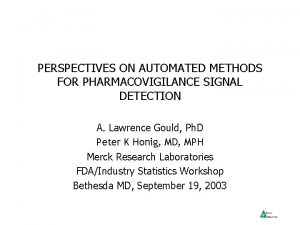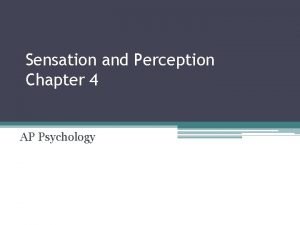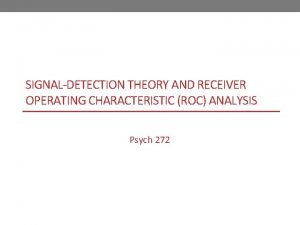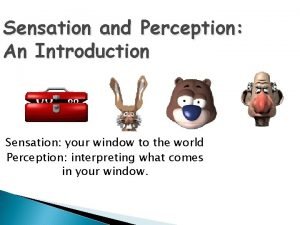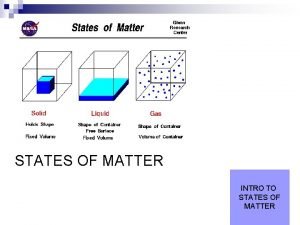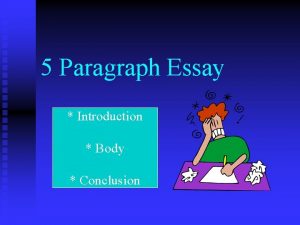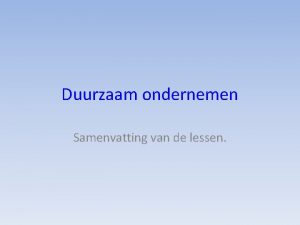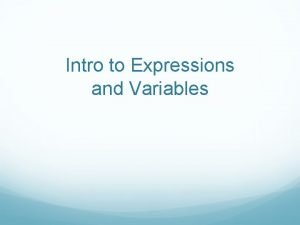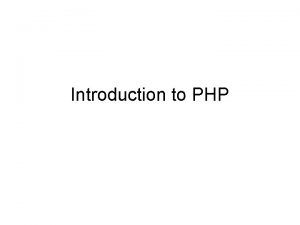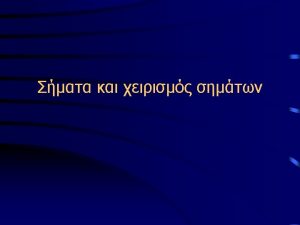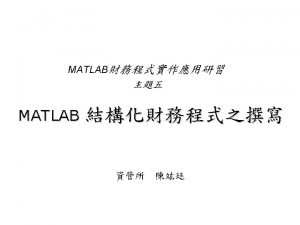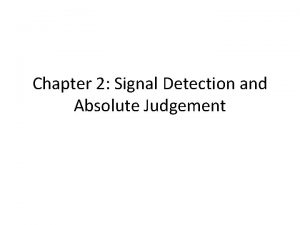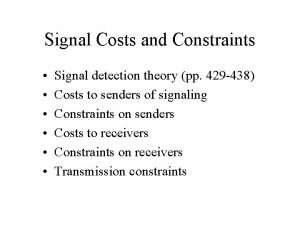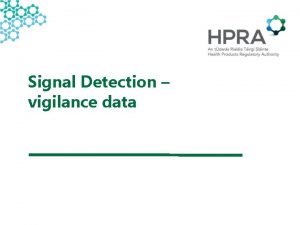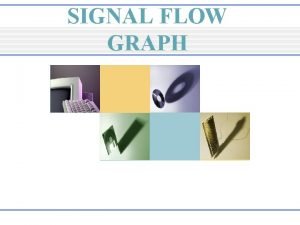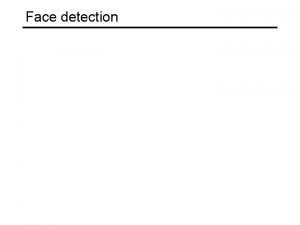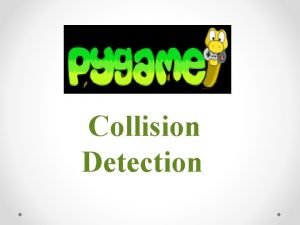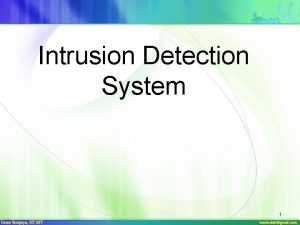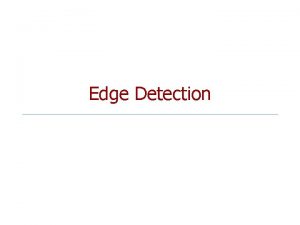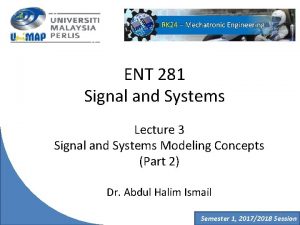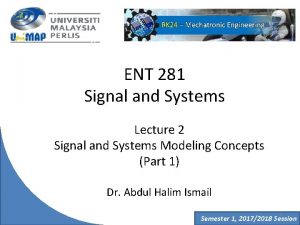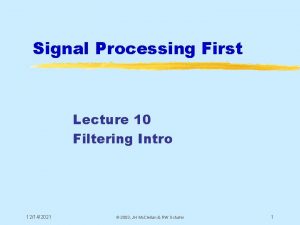Outline of Lecture I Intro to Signal Detection





































- Slides: 37

Outline of Lecture I. Intro to Signal Detection Theory (words) II. Intro to Signal Detection Theory (pictures) III. Applications of Signal Detection Theory

Part 1 Introduction to Signal Detection Theory S. D. T. In Words

Signal Detection Theory S. D. T. is a procedure for measuring sensitivity to stimulation, independent of the subject’s response bias.

Detection Experiment • We want to measure a subject’s ability to detect very weak stimuli. • Signal Detection Theory requires a “Type A” experiment. • How do we know when the subject is objectively incorrect?

“Catch Trials” The subject is asked to make a response when no stimulus has been presented (also called “noise only” trials).

Not All Errors Are Equal 1. Reporting stimulus is present when it’s absent (“false alarm”). Versus 2. Reporting stimulus is absent when it’s present (“miss”).

Correct Responses Differ, Too 1. Reporting stimulus is present when it’s present (“hit”). Versus 2. Reporting stimulus is absent when it’s absent (“correct rejection”).

Absent Present Stimulus-Response Matrix Correct Rejection False Alarm Miss Hit “No” “Yes” Response

Absent Correct Rejection False Alarm Type I error Present Stimulus-Response Matrix Miss Hit Type II error “No” “Yes” Response

Signal Detection Theory S. D. T. reduces the stimulus-response matrix to two meaningful quantities. 1. Detectability (d’) - a subject’s sensitivity to stimulation. 2. Criterion (b) - a subject’s inclination to favor a particular response; bias.

Part 2 Introduction to Signal Detection Theory S. D. T. In Pictures

Distributions of Sensory Responses

Distributions of Sensory Responses Spontaneous Activity is Constant

Distributions of Sensory Responses Spontaneous Activity is Normally Distributed The “Noise” Distribution

Distributions of Sensory Responses A Mild Stimulus is Presented (d’=1) The “Noise” Distribution The “Signal + Noise” Distribution

Distributions of Sensory Responses A Moderate Stimulus is Presented (d’=2) The “Noise” Distribution The “Signal + Noise” Distribution

Distributions of Sensory Responses An Intense Stimulus is Presented (d’=3) The “Noise” Distribution The “Signal + Noise” Distribution

Distributions of Sensory Responses Sub-Threshold Stimulus is Presented (d’=0) The “Noise” Distribution The “Signal + Noise” Distribution

About d’ So, d’ is a statistic for measuring perceptual sensitivity.

About d’ So, d’ is a statistic for measuring perceptual sensitivity. Also, d’ often refers to “detectability”, and “discriminability” in perceptual experiments.

About d’ So, d’ is a statistic for measuring perceptual sensitivity. Also, d’ often refers to “detectability”, and “discriminability” in perceptual experiments. A high d’ value -----> good performance: A low d’ value -----> poor performance.

About Bias Now let’s consider THAT OTHER aspect of behavior… bias.

About Bias: The inclination to favor a particular response. Example: The inclination to favor the “yes, I see it” response over the “no, I don’t see it” response.

About Bias Signal Detection Theory assumes that Bias can be measured according to a criterion. Criterion: A rule for converting sensory activity into an overt response.

Criterion The “Noise” Distribution The “Signal + Noise” Distribution

Neutral Criterion The “Noise” Distribution The “Signal + Noise” Distribution

Absent Present Stimulus-Response Matrix Correct Rejection False Alarm Miss Hit “No” “Yes” Response

Neutral Criterion The “Noise” Distribution The “Signal + Noise” Distribution

Liberal (low) Criterion The “Noise” Distribution The “Signal + Noise” Distribution

Conservative (high) Criterion The “Noise” Distribution The “Signal + Noise” Distribution

About Bias Just as d’ is the statistic for sensitivity, Beta ( ) is the statistic for bias. When… = 1, the criterion is neutral (no bias) the criterion is low (liberal bias) the criterion is high (conservative bias)

Part 3 Applications of Signal Detection Theory

S. D. T. Applications S. D. T. can be used in perceptual discrimination experiments.

S. D. T. And Discrimination The “slow” distribution The “fast” distribution

S. D. T. Applications S. D. T. can be used in non-perceptual research, including memory experiments.

S. D. T. And Memory The “new items” distribution The “old items” distribution

Learning Check I. Draw two bell-shaped curves (Gaussian distributions) with the same mean, but different standard deviations. II. Draw two bell-shaped curves (Gaussian distributions) with the same standard deviations, but different means. III. Draw one signal-detection-theory plot for a subject who has POOR discrimination, and another signal-detection-theory plot for a a different subject is has GOOD discrimination. IV. Finally, on the SDT plots that you just completed, draw a liberal criterion for one subject, and a conservative criterion for the other. Label each of these clearly.
 Signal detection theory example
Signal detection theory example Perceptual expectancy
Perceptual expectancy Pharmacovigilance signal detection methods
Pharmacovigilance signal detection methods Subliminal messages
Subliminal messages Signal detection theory roc curve
Signal detection theory roc curve Sensory adaptation
Sensory adaptation Intro paragraph outline
Intro paragraph outline Conclusion paragraph format
Conclusion paragraph format 01:640:244 lecture notes - lecture 15: plat, idah, farad
01:640:244 lecture notes - lecture 15: plat, idah, farad Baseband signal and bandpass signal
Baseband signal and bandpass signal Digital signal as a composite analog signal
Digital signal as a composite analog signal The product of two odd signals is:
The product of two odd signals is: Baseband signal and bandpass signal
Baseband signal and bandpass signal Lecture outline example
Lecture outline example Lecture outline example
Lecture outline example Lecture outline meaning
Lecture outline meaning Lecture outline example
Lecture outline example Example of sentence outline about education
Example of sentence outline about education Intro to matter
Intro to matter Bridge in introduction paragraph
Bridge in introduction paragraph Mvc intro
Mvc intro Introduction to electrochemistry
Introduction to electrochemistry Size in floral design
Size in floral design Conclusion
Conclusion Rekenverhalen intro
Rekenverhalen intro Intro to expressions
Intro to expressions Thematic essay example
Thematic essay example Chapter 10 marketing
Chapter 10 marketing Dns in computer networks
Dns in computer networks Bgp route maps tutorial
Bgp route maps tutorial Exercise intro chapter 1
Exercise intro chapter 1 Intro to malware
Intro to malware Intro.php?aid=
Intro.php?aid= Ibigay ang mga bahagi ng sanaysay
Ibigay ang mga bahagi ng sanaysay Vlsi design tutorial
Vlsi design tutorial Cisco ucs certifications
Cisco ucs certifications What is a jane schaffer paragraph
What is a jane schaffer paragraph Intro to ecosystems
Intro to ecosystems


